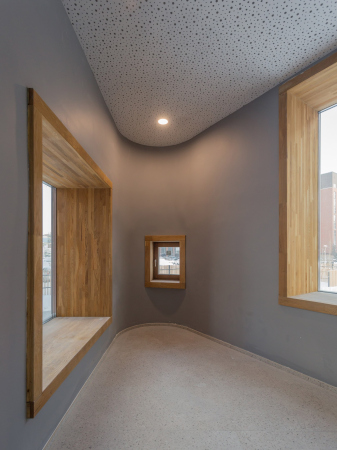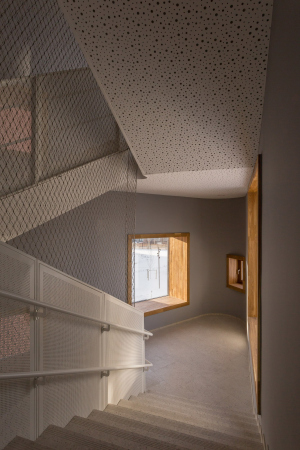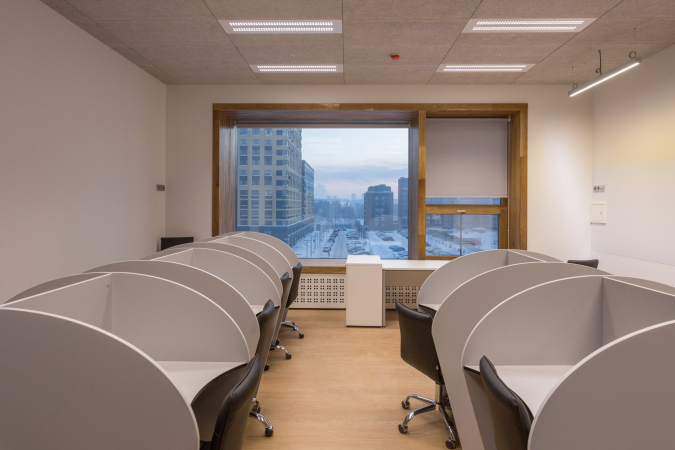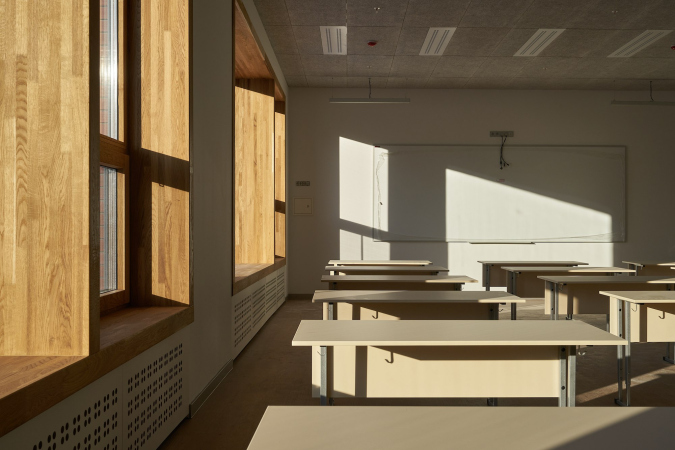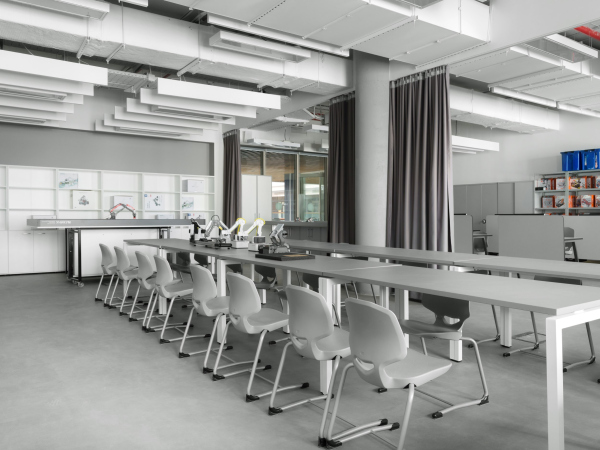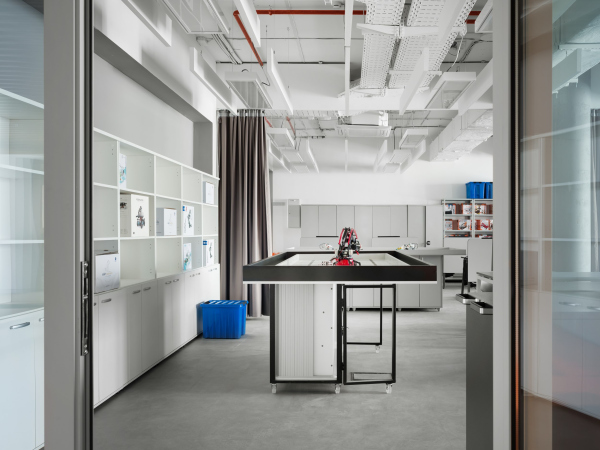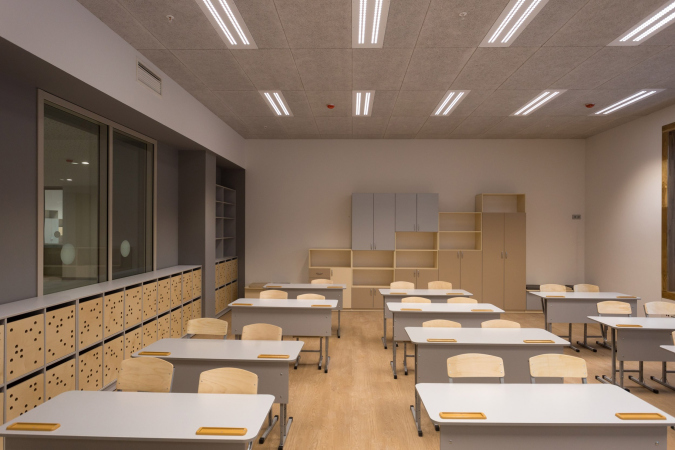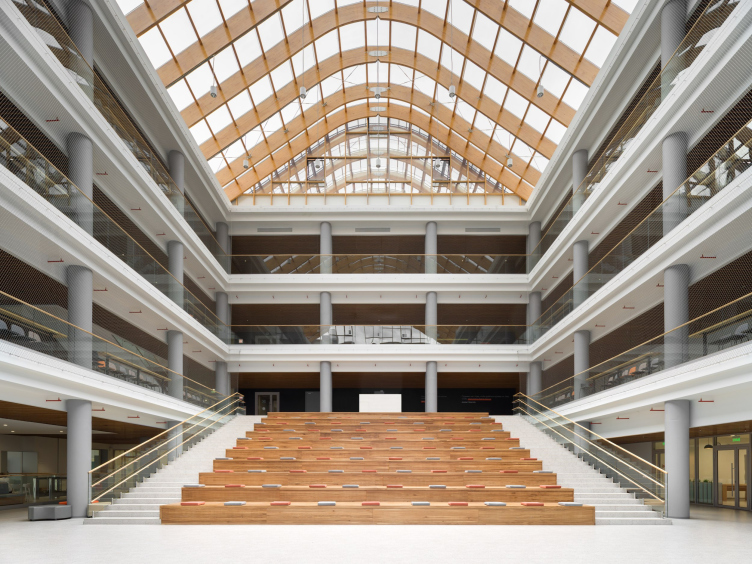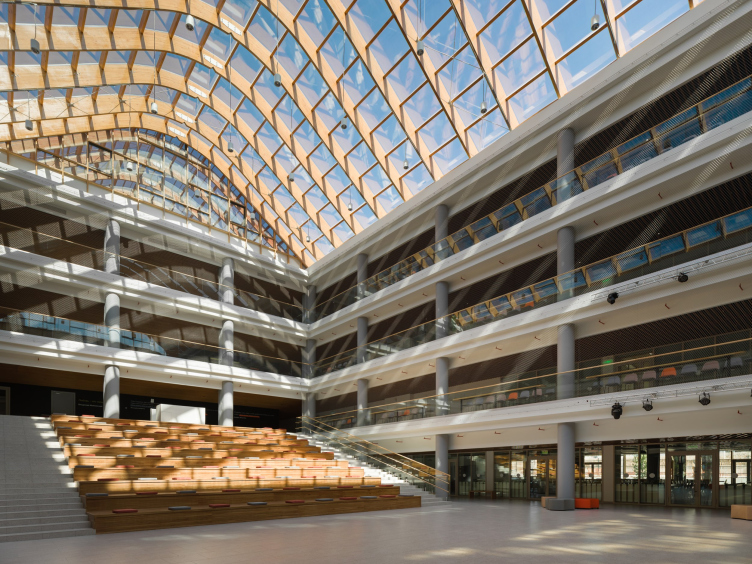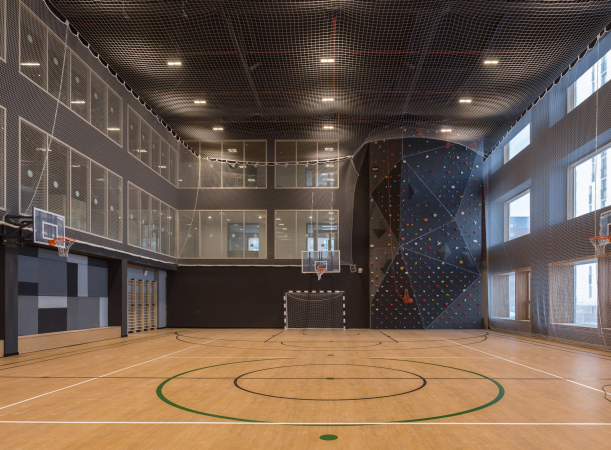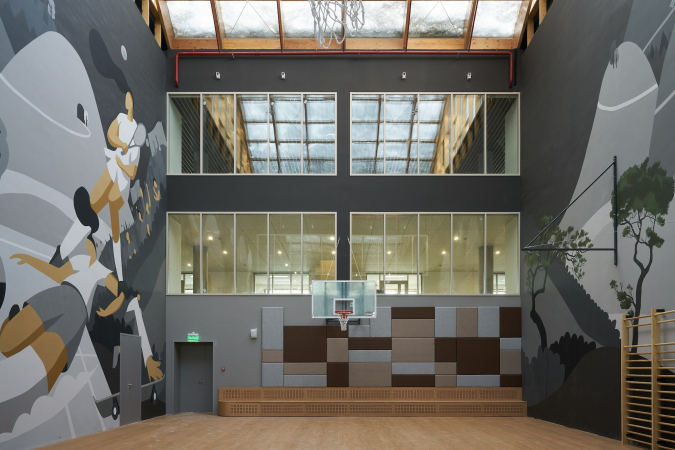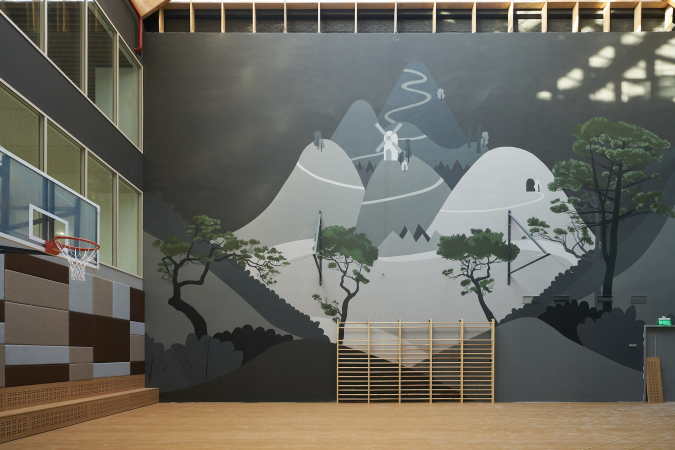As a result, the architects were able to solve the master task: the school matches the modern architecture of Evrobereg, and the solutions found by the architects proved to be so effective that the Deputy Prime Minister Marat Khusnullin proposed to make the project a model for other cities in Russia. We tell you about the key details.
The school in “Evrobereg” district
Copyright: Photograph © Dmitry Chebanenko / provided by Brusnika
The Territory of New Pedagogy
Since the endgame of the project is not new computer classes, but new ways of thinking and cognition, the first stage of the work was formulating the very task for creating a modern educational environment. The architects prepared it in cooperation with the center for development of educational systems “Smart School”.
Given that the school is a state-run one, it was necessary to rely on the Federal State Educational Standards. Experts argue, however, that the FSES are not as scary as they are commonly thought of, since they allow for individualization of curricula, varying group sizes, and timing of subjects. In this sense, much depends on the team of teachers and administrators, but also space is capable of pushing new practices. Therefore the authors rejected rigid hierarchy and division into thematic classes, striving for openness, synergy, and adaptability.
Modern school education is not limited to mastering the same amount of knowledge for everyone, and the educational process is not limited to frontal teaching methods. They have been replaced by group and individual forms of work, projects and research, discussions, mixed analogue and digital learning. The educational program itself has been transformed from a general one into a set of individual curricula, which should be implemented for all students of the school simultaneously in a single space. An important feature of the modern school is its inclusiveness, readiness to joint learning of all children, regardless of their social status, abilities and health conditions. In the process of developing the project we visited many schools, including municipal ones, where different formats of lessons were implemented, and the feedback on their effectiveness is only positive. Therefore we see the future of educational architecture precisely in the adaptability of spaces to various educational tasks.
The school in “Evrobereg” district
Copyright: Photograph © Valery Kostyunin / provided by Brusnika
The plan is simple, hence beautiful
The team of the project at once rejected the idea of an H- or U-shaped plan, characteristic of standard Soviet schools. One of the main issues with such solutions is a large schoolyard that is hardly ever used.
Plans of the standard school and the new school in Evrobereg district
Copyright: SVESMI © image courtesy by Brusnika
Instead, the architects proposed a closed rectangular contour. The courtyard evolved into a multifunctional atrium, joined by a block of small gyms, sanitary and technical rooms, resulting in most of the outer contour being free for classrooms. Vertical connections between the floors are located in the corner staircases. All of this allowed for looping corridors, avoiding dead ends, maintaining clear navigation while offering a variety of routes instead of going straight and up and down.
The concept. The school in “Evrobereg” district
Copyright: SVESMI © image courtesy by Brusnika
Another benefit is that the area of school spaces per student compared to typical projects is larger, and the volume of structures smaller. We remind you at this point that 825 students are planned.
Democracy of the Facades
The school is located in an open area, at the intersection of two important streets, and is visible from many points of Evrobereg. Therefore, all the facades clad in terracotta Klinker brick are identical, and differ only in the entrance groups and the rhythmic pattern of the large windows: the classrooms have windows measuring 2.5 x 4.5 meters, and the canteen and music room have 14 x 3.2 and 10.6 x 3.2 meters. At nightfall, the school becomes a shining beacon, radiating light.
We have always been interested in the architecture of the so-called Amsterdam Association, which is famous for its picturesque brickwork and bold forms. Its architects were inspired by exotic motifs, the poetics of ships and forts, and always talked about architecture as an adventure. It was with this same spirit that we designed the school for learning and also as a space for games, communication and unpredictable events. We very much hope that the new image of the place we invented will make school life seem less monotonous to students.
The school in “Evrobereg” district
Copyright: Photograph © Dmitry Chebanenko / provided by Brusnika
The school in “Evrobereg” district
Copyright: Photograph © Natalia Bochkova / provided by Brusnika
The school in “Evrobereg” district
Copyright: Photograph © Natalia Bochkova / provided by Brusnika
The “folds” of the corner accents host the staircases. These strong verticals are identical, but each successive one rotates 90°, forming a “swirl” when viewed from above, and making each facade look slightly different from the “human” line of vision. The massive wall takes on the malleability of a sheet of paper, capable of turning into a crane or a ship in somebody’s skillful hands.
The school in “Evrobereg” district
Copyright: Photograph © Valery Kostyunin / provided by Brusnika
The school in “Evrobereg” district
Copyright: Photograph © Valery Kostyunin / provided by Brusnika
The smoothness of the angular accents echoes in the rounded pylons of the main entrance niche, as well as in the arch of the skylight. Because the utilities are hidden in the troughs and rooms on the first and last floors, the roof acts as a fifth façade. The folds of the stair walls protrude above it, “pointing” to the skylight made of bent wooden beams and stained glass windows.
The school in “Evrobereg” district
Copyright: Photograph © Valery Kostyunin / provided by Brusnika
The school in “Evrobereg” district
Copyright: Photograph © Valery Kostyunin / provided by Brusnika
The school in “Evrobereg” district
Copyright: Photograph © Dmitry Chebanenko / provided by Brusnika
The school in “Evrobereg” district
Copyright: Photograph © Natalia Bochkova / provided by Brusnika
The educational space
Classrooms of different sizes are located along the outer contour of the three facades and simultaneously around the inner core of the atrium. The canteen and gymnasium are located on the fourth north side. The classrooms are separated from the corridors by glass partitions, which expose the educational process and allow natural light to permeate the entire building.
The school in “Evrobereg” district
Copyright: Photograph © Valery Kostyunin / provided by Brusnika
Specialized classrooms have been replaced by clusters – media and art, sports, science, and technology. At the same time, all classrooms are cross-functional and can be used to study several subjects. Their size and configuration allow for adapting to different methods of the educational process: mobile furniture can be quickly rearranged and the classroom can be prepared for a regular lesson, group work, discussion, or informal classes. About ten laboratories and workshops are designed for creative classes and after-school groups.
The Social Life
School life pulsates in the atrium with an amphitheater. Most of the time, it serves as an indoor plaza for meetings, reading, games, and recess. It also assumes the function of an auditorium, convenient for ceremonial meetings, film screenings, concerts, and plays. A timber-framed skylight floods the atrium and corridor galleries with natural light; from the galleries, almost the entire school can be seen.
The school in “Evrobereg” district
Copyright: Photograph © Dmitry Chebanenko / provided by Brusnika
The school in “Evrobereg” district
Copyright: Photograph © Dmitry Chebanenko / provided by Brusnika
The school in “Evrobereg” district
Copyright: Photograph © Dmitry Chebanenko / provided by Brusnika
On the first tier level, the atrium is connected to the music room and a 400-seat dining room. These rooms have access to terraces where students and teachers can hold informal classes, picnics, and just enjoy the fresh air.
The school in “Evrobereg” district
Copyright: Photograph © Dmitry Chebanenko / provided by Brusnika
The school in “Evrobereg” district
Copyright: Photograph © Dmitry Chebanenko / provided by Brusnika
The media cluster combines a library, lab, press center, co-working space, and book repository. The teachers’ lounge is conceived as an administrative open space with six zones: an open space for teachers to work and relax, an office, a secretariat, meeting rooms, a kitchenette, and the principal’s desk. Transparent partitions add to the openness of the teachers’ work. There are two gyms: the small one adjoins the atrium, and the large one faces the northern façade.
Wood and concrete are used in the finishing of all rooms. The window panes are coated with a special coating that protects the rooms from overheating in summer and keeps them warm in winter. The navigation and layout of the rooms are comfortable for children with hearing, vision, or mobility impairments.
The school in “Evrobereg” district
Copyright: Photograph © natalia Bochkova / provided by Brusnika
The school in “Evrobereg” district
Copyright: Photograph © Dmitry Chebanenko / provided by Brusnika
The school in “Evrobereg” district
Copyright: Photograph © Dmitry Chebanenko / provided by Brusnika
Open air lessons
For the landscaping, Brusnika invited the Novascape company, which was able to continue the educational process outside the walls and adapt the area to different functions. On the green slopes with wooden decking and pavilions you can relax or do your homework. The sports field for ball games simultaneously acts as an amphitheater and open-air laboratory. The workout and active play area with slides, balancers, trampolines, and climbing walls will help switch from mental to physical activity. In winter, an ice rink can be poured and a ski track can be laid.
The school in “Evrobereg” district
Copyright: Photograph © Dmitry Chebanenko / provided by Brusnika
The school in “Evrobereg” district
Copyright: Photograph © Dmitry Chebanenko / provided by Brusnika
In this project, we decided not to experiment with plants, and selected plants that are low-maintenance, resistant to the climatic conditions of Siberia. Around the perimeter of the site, there will appear 107 pine and poplar trees with a height of 8-12 meters, inside, there will be small linden, berry apple tree, small-leaved birch and bird cherry. The latter will bloom and give shade from the first year. The green “mass” will be formed by shrubs and perennials, selected according to the flourish calendar, and by grasses. Bushes will become buffers – meaning, they will divide zones of active games and quiet rest. About 17,000 plants will be planted here during the season.
In winter, the area won’t look like a black-and-white movie either. Coniferous trees will make the landscape attractive even in the cold season. With the onset of warmer days, the students will be able to grow greens and vegetables in the school vegetable garden, dine on the outdoor terrace, and study botany with live examples growing in the courtyard.
In winter, the area won’t look like a black-and-white movie either. Coniferous trees will make the landscape attractive even in the cold season. With the onset of warmer days, the students will be able to grow greens and vegetables in the school vegetable garden, dine on the outdoor terrace, and study botany with live examples growing in the courtyard.
The school in “Evrobereg” district
Copyright: Photograph © Valery Kostyunin / provided by Brusnika
***
The school project, as was already mentioned, is included in the practice of reapplication in the Ministry of Construction of the Russian Federation, that is, it can be replicated at the federal and regional levels. The architects believe that only the key principles and approaches should be standardized, but each individual school should claim an identity of its own.
The school in “Evrobereg” district
Copyright: Photograph © Valery Kostyunin / provided by Brusnika
The school in “Evrobereg” district
Copyright: Photograph © Dmitry Chebanenko / provided by Brusnika

















